Tips for spotting fake sourdough bread at the store so you don’t waste your money on a phony product that is an unhealthy choice.
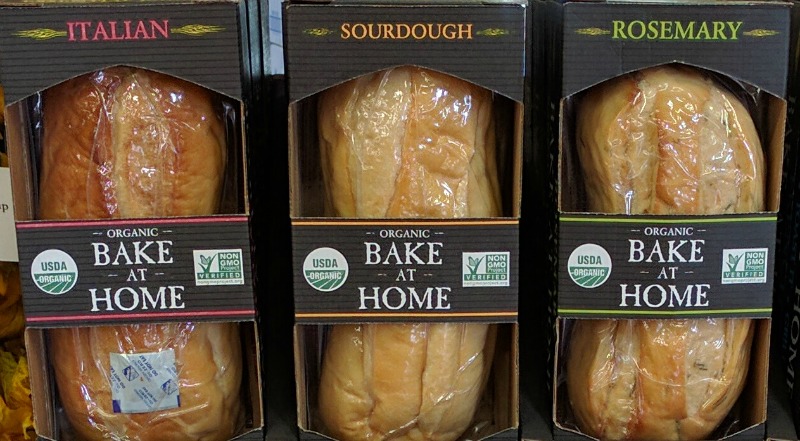
As awareness of the benefits of sourdough bread increases, so does the potential for food manufacturers – both large and small – to exploit the term.
And exploit it they most certainly do!
I recently examined every single loaf of bread at a local health food store. I found only one out of over half a dozen that claimed to be “sourdough” that was leavened in a traditional manner. No, it wasn’t The Essential Baking Company sourdough bread in the picture above. You won’t believe what this company is doing to fool consumers. Even I was shocked, and I thought I had seen it all.
If you choose to buy instead of making sourdough bread yourself (yes, it is a bit time-consuming!), then be on the lookout for fake sourdough!
It is literally everywhere!
Spotting phony sourdough is a more difficult process than you might think due in part to the sourdough myths that seem to abound.
When I first set out to write this article, I thought it would be fairly straightforward to explain. As it turns out, spotting a fake sourdough is rather tricky due to unethical food manufacturer tactics that are far sneakier and devious than I ever imagined.
You really need to be on your toes when sourcing sourdough bread to ensure that you aren’t wasting your money on a product you thought was a healthy choice for your family, but in fact, was quite the opposite.
If you use reading glasses, be sure to always bring a pair with you into the store so you can read the fine print on the packaging. If you wait until you get home to take a look, chances are you are going to be disappointed.
Fake Sourdough Masquerading as Real
The picture above shows one of the most popular fake sourdoughs on the market as of this writing. I was asked to take a look at it by a reader who thought it was legit. This brand is available at many health food stores. At my local Whole Foods, it is very prominently placed with an attractive display right near the checkout lines.
Some folks have notified me that it is also available at Sam’s Club and Walmart mega-supermarkets too!
Notice how the company has taken great care to appeal in every way to the health-conscious, time-challenged consumers:
- The loaf is clearly labeled “Sourdough”.
- The USDA Organic certification is front and center on the box.
- The NonGMO Verified label is prominently shown.
- The term “Bake at Home” is used to catch the eye of time-strapped consumers, some of whom WANT to provide fresh-baked sourdough for their family, but just don’t have the time.
I give this label a 10 out of 10. Fantastic marketing that is sure to move those boxes off the shelf like hotcakes. It’s even priced like a real sourdough would be at $6+/loaf where I live.
Watch Out for Ingredients Listed on the Box vs Online
Here’s the sneaky part. The ingredients on the label of this phony sourdough are DIFFERENT than what is on the website. Yes, the company has obviously done its research. Consumers are increasingly checking out products online before buying.
Don’t fall for this trick. Below is an online screengrab from December 28, 2016, of the ingredients for this company’s “sourdough” bread:
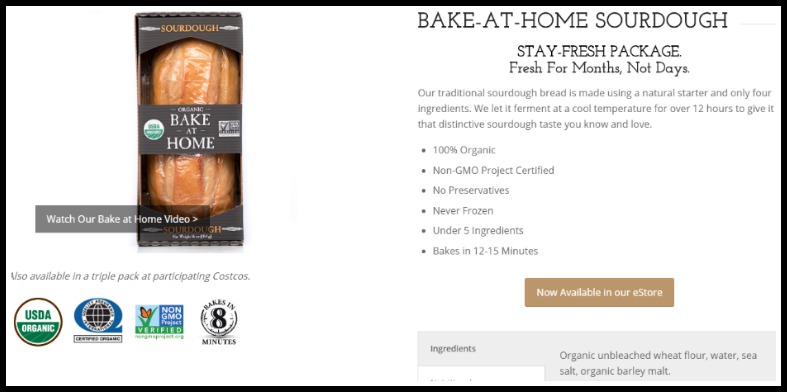
Notice the ingredients say: organic unbleached wheat flour, water, sea salt, organic barley malt.
To semi-researched consumers who know enough about sourdough bread to understand that it never contains yeast, this is enough information to fool them and get them to buy.
Take care not to be easily fooled, however! Look what I found when I looked at the actual label of this very same sourdough bread at the store. Check out the photo below taken on the very same date – December 28, 2016.
The exact same sourdough bread has YEAST listed on the box!
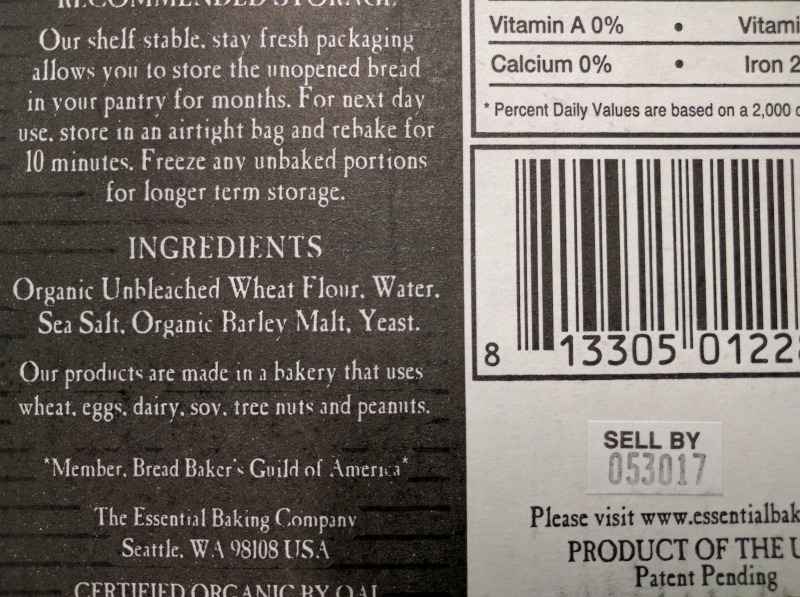
This is a new tactic I have not been aware of before … listing different ingredients for a product online versus what is on the label. Online it states “under five ingredients” using a “natural starter” with the bread “fermented” at a cool temperature for over 12 hours. The box at the store, however, lists 5 ingredients and the “natural starter” turns out to be yeast, which is most decidedly unnatural when it comes to sourdough! Other problems with this bread include the use of sweetener (organic barley malt) and white flour.
If a product seems too good to be true, it probably is.
I mean, seriously? Would an authentic sourdough come in a convenient “bake at home in 12-15 minutes” package that is shelf-stable for nearly 6 months?
Absolutely not!
The short video below summarizes the issues and how to spot the good stuff.
Authentic Labels
The label of true sourdough bread is going to list sourdough starter instead of yeast in the list of ingredients. For example, the gluten-free sourdough bread I buy from a local bakery has “cultured brown rice flour” listed as the starter.
The wording for the sourdough starter varies from brand to brand.
However, there will usually be some indication of a cultured starter as the leavening agent.
This starter contains natural beneficial yeasts from the environment rather than processed baker’s yeast which increases baking speed and baking temperature.
This is important because naturally leavened bread is more digestible, nutritious and less likely to trigger allergy problems than modern, yeast rise bread.
Ultimately, the consumer really must take the time to ensure that the sourdough bread of their choosing really is what it claims.
The Sourdough Bread I Buy
Real sourdough bread is so difficult to find that I’ve resorted to shipping freshly baked sourdough direct from the bakery to my door.
The bakery I use is Organic Bread of Heaven and I order the Rustic Sourdough. I ship in six loaves at a time and freeze what I won’t use in 4-5 days. They also have sourdough bagels, tortillas, hamburger buns, and English muffins among other authentic items.
Free shipping is available for orders over $49 (ask a friend to jump in with you!). The price is several dollars cheaper per loaf than the bread at the health food store.
To give it a try, use coupon HEALTHYHOME (all caps) for 10% off your first order.
Even if you pay shipping by ordering just a few real sourdough loaves, the price per loaf is still comparable to the fake sourdough at the health food store!
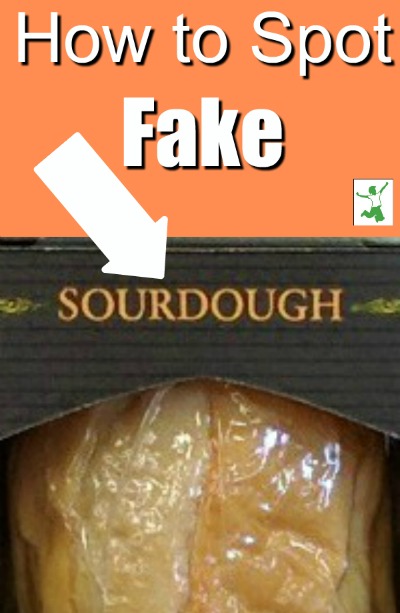
Rules of Thumb
Here are some rules of thumb to identify authentic sourdough bread:
- A handful of ingredients
- No yeast
- Cultured flour starter
- No sweetener
- Made using whole grain flour
- The dough ferments before baking for at least 4-6 hours
After examining the label, if you are still unsure, make a phone call or email to the company. Ask how long the sourdough is allowed to rise (double in size) before baking.
A true sourdough is going to rise for a minimum of about 4-6 hours and even as long as 10-15 hours depending on the temperature.
No baker’s yeast is needed. In addition, no sweetener should appear on the label.
Fake Sourdough At Panera
Be aware that Panera markets its sourdough as real when it is fake too.
Longtime reader Beth S. sent me this email from Panera customer support when she inquired about the authenticity of its sourdough bread. Beth gave her permission to reprint this email.
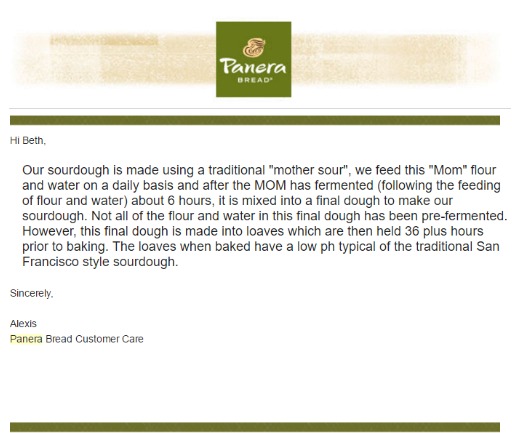
While this answer sounds promising, examining the ingredients of Panera Bread’s sourdough quickly identifies it as a fake. From the Panera website:
Unbleached Enriched Wheat Flour (Flour, Malted Barley Flour, Niacin, Reduced Iron, Thiamine Mononitrate, Riboflavin, [synthetic] Folic Acid), Water, Salt, Yeast (Yeast, Sorbitan Monostearate, Ascorbic Acid [GMO]), Dough Conditioner (Ascorbic Acid [GMO], Microcrystalline Cellulose [refined wood pulp], Corn Starch [GMO])
Not only is the Panera sourdough a phony, but it also contains yeast, wood pulp, and GMOs. It is also fortified with synthetic vitamins including dangerous folic acid (instead of natural folate).
At least The Essential Baking Company’s fake sourdough described earlier in this article is organic. This means no GMOs or other toxic ingredients.
As you can see, the phony sourdoughs on the market today range from simply misleading to downright dangerous. Best to avoid them all and get the real thing!
Do you currently buy an authentic sourdough? If so, what are the ingredients and what is the brand?








Hi. Is whole wheat flour different from whole grain flour ? Is whole wheat flour ok ? Organic of course and no yeast used.
Whole grain means that it is probably a blend of multiple grains or types of wheat. Organic whole grain flour is fine as is organic whole wheat flour (if you tolerate it).
At Boudin, they list calcium sulfate and enzymes. My initial reaction was bummer, this one isn’t real either (been looking for a while for real sourdough bread). Enzymes are not really that same as cultures are they? Thanks. (Also, thanks to Kimberly for the tip re Sprouts).
Enzymes are not the same as cultures.
Sour dough starter IS yeast. So how do you know if a company if referring to their sour dough starter as yeast? Esp when some legitimate sour dough products don’t even mention it all? The term ‘yeast’ could mean sour dough starter, that alone is no indication of anything, other than the presence of yeast.
What I am saying is that added baker’s yeast at the time of baking is a problem. If it is added, it is on the label. If the label just says sourdough starter, flour and water (and maybe some salt) then you are good. Of course sourdough starter is cultured using wild yeasts in the environment.
While I agree with most of your article there are a few things you missed. Yeast isn’t bad in small amounts. In France you can still call sourdough traditional if the percentage is below 0.4%. We make our sourdough with 0.2% yeast, just for consistancy of product in bulk amounts. And the dough only has flour, water, salt, starter and yeast. The methods are also traditional, an autolyse, 3 hours fermentation with 5 stretch and folds, then moulding and 15 hours fridge fermentation, before baking at 2am the next morning. While I understand the huge amounts of fake sourdough out there, just because there is yeast, it might still be sourdough.
Sarah, there’s nothing unnatural or wrong with baker’s yeast. It’s a species called Saccharomyces cervisiae, and it is also known as “brewer’s yeast”. Through centuries of selective breeding, it has been tailored for high activity and consistent performance. However, if commercial sourdough bread lists “yeast”, “baker’s yeast” or “brewer’s yeast” as an ingredient, it’s a tip-off that it’s not real sourdough, as S. cervisiae doesn’t produce sourdough. To impart a sour flavor, the baker would need to cheat by adding fumaric acid or some other acidifier. Moreover, it is not possible to mix baker’s yeast and sourdogh starter, as the different species of yeast will compete with each other, producing a poor rise, instead of a fast rise with sour flavor.
I agree that there is nothing inherently wrong with bakers yeast … however, when you bake bread with it, you do not give sufficient time for the anti-nutrients in the grain to break down. Making bread with a traditional sourdough starter allows this extra time and, in addition, you bake at a lower temperature for longer which improves digestibility even more while at the same time preserving more of the nutrients. Traditionally made sourdough bread is much more digestible and nutritious than quick rise bread made with bakers yeast.
So yeast is unnatural? If so what are good flours or alternatives to yeast? Sourdough or not. We always make our own bread so I’ll like to know if a change is needed! Thank’s for the good info.
Baker’s yeast is a modern and unhealthy way to raise bread in the oven. Using a sourdough culture is the traditional method that results in a far healthier and more easily digested loaf.
What if you are trying to avoid lecitns as much as possible and need a good white sourdough bread, what should i look for in the ingredients? Any suggestions on brands? Thank you!
I recommend getting the Weston Price shopping guide for a complete list of vetted sourdough brands.
I found another one today…sprouts makes one daily and as per your instructions I checked the label and no yeast or bad stuff…actually used sourdough starter from whole wheat and spelt. I paid 3.50 for a fresh baked loaf! It’s their sprouts market corner sourdough. I didn’t check the take and bake version just the fresh paper bakery bag version
I have found that it is almost nearly impossible to find a true sourdough bread that does not have additional ingredients. Trader Joe’s just stopped selling A bread named pain Pauline which had three ingredients: organic whole wheat, salt, and water . It was divine and delicious. I contacted them to see why they stopped selling it in my neighborhood, and their answer was that there was not enough people purchasing it. I am dumbfounded as to why anyone would purchase breads that are full of chemicals and stead of something that is so delicious and nutritious. I’ve tried Berlin Bakery, but the taste does not compare. Do you know any other bread sources?
Be careful calling anything that lists “yeast” in its ingredients as fake. A few bakeries here in Europe have gone the “full truth” route listing both yeast and lactobacillus cultures as their ingredients, and these are, of course, the two organisms that provide the unique environment of a sourdough starter culture. You can;t say “sourdough doesn’t have yeast” because of course it does – you just start your sourdough culture with “wild yeast” that you “capture” from the air in your kitchen and what has been growing naturally on the grains that were ground up to make your flour. Lactobacillus – the bacterium that sours milk – is also in your kitchen’s air and when a wild yeast moves in to your mixture of flour and water the chemical environment set up by the yeast devouring the nutrients in the flour sets up an ideal environment for lactobacillus to also colonize the culture. It’s this symbiosis between yeast and lactobacillus that creates the unique sourdough starter.
So if it says “yeast” on the ingredient list but says “lactobacillus” as well, it’s probably as real as if it says “cultured flour”
Wild yeast is definitely in sourdough. That’s how you make sourdough starter after all … by feeding the dough as it is exposed to wild yeasts in the environment. https://www.thehealthyhomeeconomist.com/make-sourdough-starter/